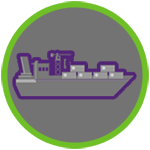10 Essential PPE Requirements in The Workplace | Stay Safe
In today’s dynamic work environments, safety remains paramount. From bustling construction sites to the methodical hum of laboratories, protecting the workforce from potential hazards is not just a responsibility but a necessity. Personal Protective Equipment, commonly known as PPE, plays a pivotal role in this protective strategy. However, merely having PPE isn’t enough.
Understanding the essential requirements for its effective use is crucial for ensuring that employees are not just wearing protective gear but are shielded adequately. In this blog, we’ll delve into the ten essential PPE requirements in the workplace, offering insights into the best practices that can shape a safer, more secure professional space for all. Join us as we navigate the nuances of workplace safety, one protective measure at a time.
What Is PPE? ![]()
PPE stands for Personal Protective Equipment. It refers to protective clothing, helmets, goggles, or other garments or equipment designed to protect the wearer’s body from injury or infection. The hazards addressed by protective equipment include physical, chemical, biological, electrical, heat, and airborne particulate matter.
PPE is crucial in a variety of settings and industries, ranging from healthcare, where workers need protection from germs and viruses to construction sites, where workers need protection from falling objects, dust, and other physical hazards.
The main purpose of PPE is to reduce the risk of injury or harm to individuals by creating a barrier between the worker and the hazard. However, it’s important to note that PPE is often considered the last line of defense after other safety measures (like engineering controls or administrative controls) have been considered or implemented.
10 Essential PPE Requirements You Need To Know
Ensuring the safety and health of workers is of paramount importance, and using the right Personal Protective Equipment (PPE) is a critical aspect of this. Here are 10 essential PPE requirements that everyone should be aware of:
- Risk Assessment
A risk assessment is a systematic process of evaluating potential hazards in a workplace. This involves observing work procedures, analyzing the environment, tools, and materials used, and understanding the sequence of work-related tasks. Through a risk assessment, employers can identify potential health and safety risks that could cause harm.
It’s crucial to consider both the likelihood of a hazard occurring and the potential severity of its impact. By thoroughly understanding the risks, businesses can make informed decisions about the need for PPE and other safety measures, ensuring that workers are protected from identified risks.
- Selection of Appropriate PPE
After determining the risks, it’s essential to choose the right type of PPE. PPE varies widely based on the nature of potential hazards – from chemical-resistant gloves for handling harmful substances to hard hats for construction sites where falling objects are a concern.
The PPE selected should be specifically designed to protect against the identified hazard. For example, while a surgical mask might be suitable for minimizing the spread of germs, it wouldn’t be adequate protection against harmful chemical vapors.
- Proper Fitting
The effectiveness of PPE often hinges on its fit. If it doesn’t fit the user correctly, its protective features could be compromised. For instance, a safety helmet that’s too large could easily fall off, rendering it useless.
Similarly, goggles that don’t form a proper seal might allow harmful particles to enter. Hence, employers need to ensure that employees have access to different sizes and styles of PPE to find the one that provides a snug and comfortable fit, ensuring maximum protection.
- Training And Education
Merely providing PPE is not enough. Employees need to know when and how to use it. Training should encompass the purpose of the PPE, its limitations, proper wear and adjustment, and the maintenance and disposal procedures.
For instance, while wearing gloves in a lab setting, an employee should know how to handle and dispose of them safely after coming into contact with hazardous materials. Such training ensures that PPE is used correctly, consistently, and effectively.
- Maintenance And Inspection
Like all tools and equipment, PPE is subject to wear and tear. Regular inspection is necessary to identify signs of deterioration, damage, or defects. Any compromised PPE should be replaced immediately. Maintenance might also involve cleaning, disinfection, or minor repairs.
For instance, reusable respirators need to be regularly cleaned and have their filters replaced, while the structural integrity of hard hats should be inspected for cracks or other damage. By ensuring that PPE is well-maintained and in good working order, employers can be confident in its ability to protect employees from workplace hazards.
- Replacement
The effectiveness of PPE hinges not just on its design but also its condition. Over time, with regular usage, PPE can become damaged or worn out, reducing its protective capabilities. For example, safety goggles with deep scratches might obstruct vision, or respirator masks with worn-out filters might not effectively filter contaminants.
Continual exposure to hazardous elements can also weaken the materials, rendering them less protective than they were originally. As such, any PPE showing signs of significant wear, damage, or any other compromise must be replaced immediately to ensure the safety of the wearer.
- Hygiene And Cleanliness
Cleanliness plays a pivotal role in the effectiveness of some PPE, especially in environments prone to biological hazards. For instance, reusable PPE like face masks or goggles must be thoroughly cleaned and, if necessary, disinfected after each use to prevent cross-contamination.
Dirty or contaminated PPE can become a source of infection or disease transmission, negating the very purpose of using protection. Proper protocols, including cleaning and disinfection procedures, should be in place to ensure the hygiene of all PPE.
- Accessibility
The best PPE is of no use if it’s not readily available when needed. PPE storage should be strategically located in areas where risks have been identified, allowing employees to quickly equip themselves when transitioning to hazardous tasks or areas.
Imagine a chemical spill in a lab – the nearest eyewash station or chemical-resistant gloves should be within seconds of reach. Hence, clear signage indicating the location of PPE and well-organized storage ensures that employees can rapidly access and utilize them in times of need.
- Legal Compliance And Standards
Adhering to regulations isn’t just about avoiding legal repercussions; it’s about ensuring a universally recognized standard of safety. Regulatory bodies, like OSHA in the U.S., have established guidelines and standards for PPE based on rigorous research and proven safety practices.
By adhering to these standards, employers not only ensure legal compliance but also align their safety measures with best practices. Regularly updating the company’s understanding and adherence to these regulations ensures the highest level of safety and avoids potential legal complications.
- Emergency Preparedness
While everyday operations carry their own set of risks, emergencies can amplify hazards exponentially. In the event of fires, chemical spills, or other sudden crises, regular PPE might not suffice. Specialized equipment, like emergency respirators or heat-resistant suits, might be necessary.
Incorporating PPE into an organization’s emergency preparedness plan ensures that employees are equipped to handle unexpected and heightened risks. This means having extra stockpiles of emergency-specific PPE, training employees on their use, and rehearsing emergency protocols to ensure swift and efficient responses when every second counts.
Remember, PPE is considered as the last line of defense in the hierarchy of hazard controls, and it should be used in conjunction with other controls to ensure a safe and healthy working environment.
Conclusion
In the vast tapestry of workplace safety, Personal Protective Equipment stands out as an indispensable thread. But as we’ve discovered, it’s not just about equipping workers with PPE – it’s about ensuring its appropriate selection, usage, maintenance, and more. By adhering to the essential requirements highlighted in this blog, employers can foster an environment where safety isn’t just a checkbox but a deeply ingrained culture.
Remember, a well-protected workforce isn’t just more productive; it’s a testament to an organization’s commitment to its most valuable asset – its people. As we navigate the challenges of various industries, let’s prioritize the well-being of every individual, ensuring that safety remains at the forefront of all endeavors.


















